Pesticide Usage in Scotland: Rodenticides on Grassland & Fodder Farms 2017
This report presents the results of a survey of rodenticide use on grassland and fodder farms in Scotland in 2017.
This document is part of a collection
Rodenticide use data
Rodenticide use data were collected from 635 grassland and fodder holdings (472 and 163 respectively) in Scotland in 2017. The growers surveyed represented six per cent of the holdings growing fodder crops and one per cent of those with grassland. These holdings collectively grew 12 and four per cent of the 2017 Scottish fodder and grass crop area respectively. Rodenticide use data from these sampled farms were used to estimate rodenticide use on all Scottish grassland and fodder farms in 2017.
Percentage of farms using rodenticides and type of user
It was estimated that on almost two thirds of Scottish grass and fodder farms (65 per cent) no rodenticides were used in 2017 (Figure 1). On those farms where rodenticides were applied (35 per cent of farms) almost three quarters of baiting operations (73 per cent) were implemented by farmers. Pest Control Professionals ( PCPs) conducted baiting on the remainder of these farms. However, it should be noted that, despite the fact that on the majority of farms baiting was conducted by farmers; farmers and PCPs used very similar amounts of rodenticides overall (refer to page 9).
Figure 1 Percentage of grassland and fodder farms using rodenticides and type of user - 2017
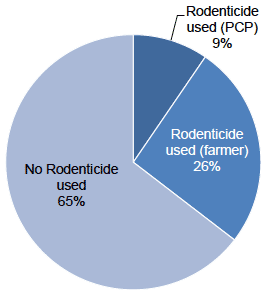
Note: in the previous report (2013) farmer and PCP use was based on sample data rather than an estimation of the pattern in the total population (refer to Appendix 4). In the text below the 2013 data has been re-analysed to allow direct comparison between the surveys.
The pattern of rodenticide use, and primary user, encountered in this survey is similar to that reported in the previous survey in this series [ 1] (Figure 2). However, in 2013 the proportion of grass and fodder farms using rodenticides (43 per cent) was significantly greater (P<0.001) than in 2017. In 2013, on farms where rodenticides were used, 78 per cent of use was by farmers and 22 per cent by PCPs (no significant difference between the 2013 and 2017 surveys, P=0.32).
Figure 2 Percentage of grassland and fodder farms using rodenticides and type of user - 2013 & 2017
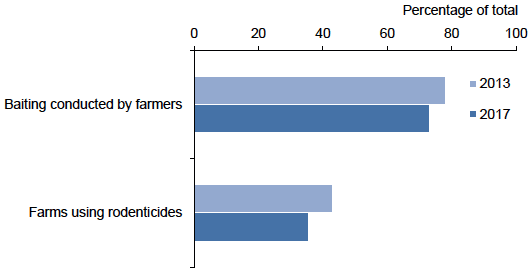
Note: The reduction in farms using rodenticides is statistically significant (P<0.001)
This is in contrast to the pattern reported on arable farms where rodenticide use, and use of PCPs, is more prevalent. In the 2016 arable farms survey [ 2], 78 per cent of arable farms used rodenticides and 40 per cent of farm baiting was conducted by PCPs.
Rodenticides encountered and their estimated occurrence
During this survey, product information was recorded for 89 per cent of all occurrences of rodenticide use. For the remaining 11 per cent, whilst it was recorded that rodenticides had been applied, the product used was not specified. This was either a result of farmers not having adequate records of the exact product used or PCPs not responding to requests for product details. The level of unspecified rodenticides in 2017 was similar to that encountered in the previous survey (8 per cent). The following sections only discuss the use of specified rodenticides.
Rodenticide occurrence is the number of holdings on which a formulation (the combination of active substances formulated together in a product) is encountered. Multiple uses of the same formulation at the same holding are counted as a single occurrence (refer to Appendix 3 for further explanation of these definitions).
Seven active substances were recorded on grass and fodder farms in 2017; brodifacoum, bromadiolone, coumatetralyl, difenacoum, difethialone, flocoumafen and warfarin (Table 1, Figure 3). All of the rodenticides encountered were anticoagulants, which prevent the synthesis of blood clotting factors and cause rodent death by haemorrhage. The active substances encountered represent all anticoagulant rodenticides currently approved in the UK.
Five of these compounds are second generation anticoagulant rodenticides ( SGARs; brodifacoum, bromadiolone, difenacoum, difethialone and flocoumafen) and two are first generation anticoagulant rodenticides ( FGARs; coumatetralyl and warfarin). As in the previous survey, the SGAR compounds were the most widely used, accounting for more than 99 per cent of total occurrences of rodenticide use.
The most commonly used active substances were difenacoum and bromadiolone (53 and 40 per cent of all occurrences respectively). More limited use of brodifacoum (4 per cent of occurrences), difethialone (one per cent), flocoumafen (one per cent), coumatetralyl and warfarin (both less than one per cent) was also recorded.
The dominance of difenacoum and bromadiolone occurrence reflects their being the most commonly available rodenticides. At the time of writing, difenacoum and bromadiolone containing products account for 74 per cent of all anticoagulant rodenticide approvals, 73 per cent of those approved for outdoor use around buildings and 97 per cent of those approved for use in open areas [ 3].
Figure 3 Percentage occurrence of rodenticide active substances on grassland and fodder farms - 2017
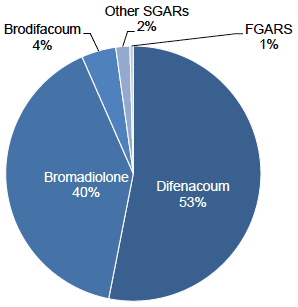
Note: Other SGARs are difethialone and flocoumafen. FGARs are coumatetralyl and warfarin
The occurrence of the three main rodenticides recorded in the 2013 and 2017 surveys (bromadiolone, brodifacoum and difenacoum) shows little difference in use pattern over time, although brodifacoum use decreases from 8 to 4 per cent of total occurrences (Figure 4). These three compounds collectively accounted for 99 and 98 per cent of total occurrences of use in 2013 and 2017 respectively. No non-anticoagulant rodenticides were reported to have been used in the 2017 survey. In 2013 a small amount of aluminium phosphide was reported to have been used for rodent control (less than one per cent of total rodenticide occurrences).
Figure 4 Percentage occurrence of rodenticides on grassland and fodder farms - 2013 & 2017
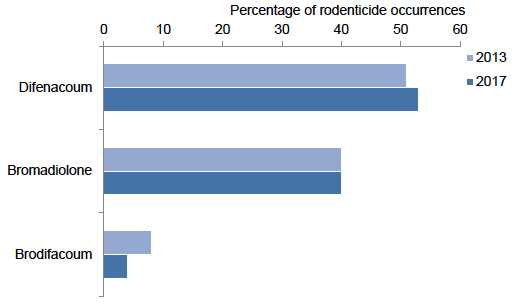
Weight of rodenticides used
Approximately 130 tonnes of rodenticidal products are estimated to have been used on Scottish grass and fodder farms in 2017 (Table 2, Figure 5).
In line with the occurrence data, more than 99 per cent of the total weight used was of SGAR products. Products containing bromadiolone were the most commonly used (ca. 77 tonnes), accounting for 59 per cent of total rodenticide use by weight. Difenacoum products were the second most commonly used (ca. 48 tonnes) accounting for 37 per cent of total use. Brodifacoum was the only other rodenticide regularly encountered (ca. 3 tonnes), accounting for two per cent of total use. Individual formulation weights, the weight of active substances present in the product not including baits, are also presented in Table 2. Anticoagulant rodenticide products contain very small amounts of active substance. The ca. 130 tonnes of rodenticide product used on grass and fodder farms in 2017 contained only ca. 6.5 kg of active substance, the remainder of the product weight is almost exclusively food bait used to attract rodents.
Figure 5 Percentage weight of rodenticide product used on grassland and fodder farms - 2017
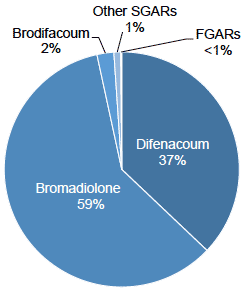
Note: Other SGARs are difethialone and flocoumafen. FGARs are coumatetralyl and warfarin
The estimated weights of the three main rodenticides recorded in the 2013 and 2017 grassland and fodder crop surveys are presented in Figure 6. There has been a large decrease in overall weight of rodenticide products applied between these two surveys. Rodenticidal product use in 2017 (ca. 130 tonnes) was 40 per cent lower than in 2013 (ca. 217 tonnes). This decline in overall rodenticide use on grassland and fodder farms is similar to that recorded in recent arable farm surveys. The weight of rodenticide products used on Scottish arable farms in 2016 was 19 per cent lower than in 2014 and 30 per cent lower than 2012.
Figure 6 Weight of rodenticide product used on grassland and fodder farms - 2013 & 2017
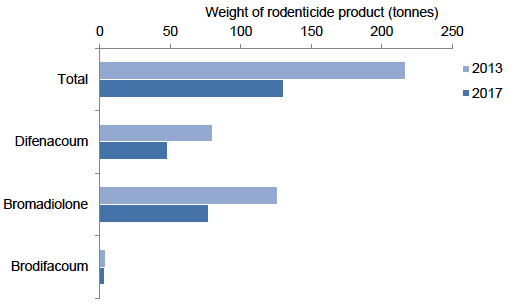
Although farmers were responsible for baiting on the majority of farms where rodenticides were used (73 per cent) in 2017, very similar amounts were applied by PCPs (ca. 65.4 tonnes) and farmers (ca. 64.4 tonnes) overall. This pattern in weight applied is different to that encountered in 2013, in which farmers baited on 60 per cent of those farms using rodenticides and applied 69 per cent of the total rodenticides used by weight (unpublished data). Therefore, the decrease in estimated rodenticide use in this survey stems largely from a decrease in use by farmers (57 per cent reduction in weight) whilst use by PCPs remains relatively unchanged over time (3 per cent reduction).
At active substance level, similar declines were recorded for both difenacoum and bromadiolone use (40 and 39 per cent respectively) in 2017. Applications of products containing brodifacoum also decreased, but the decrease (18 per cent) was less marked (Figure 6).
The reasons for these declines are unclear, and it should be noted that rodent populations, and thus rodenticide use, fluctuate over time. However, these declines, which have been detected in both arable and grass and fodder crop systems, may have been influenced by the Campaign for Responsible Rodenticide Usage ( CRRU) guidance for best practice [ 4] and the 2015 launch of the UK industry led rodenticide stewardship scheme [ 5].
Seasonal use of rodenticides
The season in which rodenticides were used was specified for 99 per cent of all rodenticides encountered. Fifty four per cent of use was reported to occur throughout the year. This included farms practising permanent baiting and those conducting multiple separate baiting operations. This is a reduction from the level of year round baiting encountered in the 2013 survey, in which 75 per cent of rodenticides were reported to be used in year round baiting regimes. This pattern of reduction in year round baiting has also been encountered on arable farms; reducing from 65 per cent by weight in 2012 to 51 and 46 per cent in 2014 and 2016 respectively. It is possible that this may have been influenced by the CRRU code of rodenticide best practice, which discourages permanent baiting [ 4].
When the weight used, including year-round use, is separated into constituent seasons, the greatest use was in winter (37 per cent) and autumn (32 per cent), with lower use during spring and summer (Figure 7). This is a very similar seasonal pattern to that encountered in previous surveys of rodenticide use in both grassland and arable systems.
Figure 7 Seasonal use of rodenticides on grass and fodder farms (percentage of total weight) - 2017
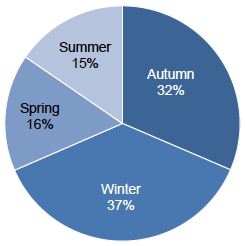
Rodenticide bait type and target
Baits formulated with grain were the most commonly encountered in this survey, accounting for 88 per cent of use by weight (Figure 8). These baits were primarily loose grain and place packs containing grain, but also included a small amount of pelletized/block grain (one per cent of total grain baits) and grain based paste (less than one per cent).
The other types of rodenticide products encountered included wax based baits, which accounted for 10 per cent of use. Ninety six percent of wax baits were solid wax blocks and four percent were soft wax. Pasta based bait contributed two per cent of total use and other paste rodenticides (for which the type of bait wasn't specified) accounted for less than one per cent.
Grain baits also accounted for the majority of rodenticides used in the previous grass and fodder farm survey in 2013 (80 per cent) and in the 2016 arable farm survey (86 per cent).
Survey respondents were asked to state the target of their rodenticide baiting regimes (Figure 9) and this information was supplied for 99 per cent of estimated use by weight. Where reason data were supplied the most common target was rats (57 per cent) followed by a combination of rats and mice (37 per cent). Six per cent of rodenticide use was targeted at mice alone. Rodenticide target data were not collected in the 2013 grass and fodder farm survey. However, the target data reported here are very similar to that recorded in the 2016 arable farm survey (rats 58 per cent, rats and mice 39 per cent and mice 3 per cent).
Figure 8 Type of rodenticide bait used on grass and fodder farms (percentage of total weight) - 2017
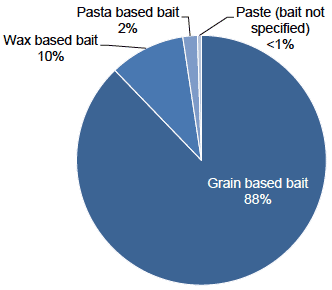
Figure 9 Target of rodenticide use on grass and fodder farms (percentage of total weight) - 2017
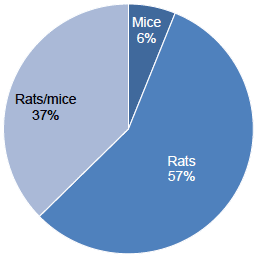
Contact
There is a problem
Thanks for your feedback